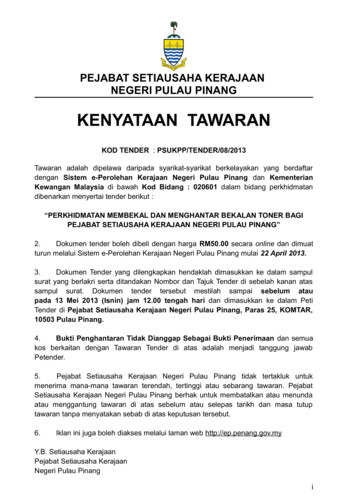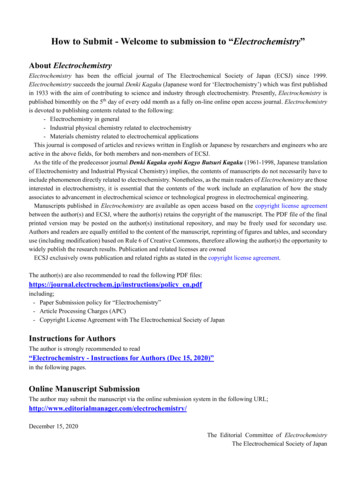A History Of Haiku In Canada T. A. Carter
A History of Haiku in CanadaT. A. CarterVancouver was the heart of Japanese Canada. In the pre-war years the city was home to nearly40% of the Japanese-Canadian population, of which the great majority was concentratedin the small area along Powell Street, forming an ethnic enclave known as Nihon-machi(Japantown), or “Little Tokyo.” Political, economic, educational, and religious institutionsthrived here. Smaller communities were also formed throughout the province: Steveson andother fishing villages, sawmill towns along the Pacific coast and on Vancouver Island, andagricultural communities in the Fraser and Okanagan valleys.Immediately after the Pearl Harbour attack on December 7, 1941, all persons of Japanesedescent, even Canadian citizens, were identified as “enemy aliens.” Within hours, theentire fleet of the 1,200 fishing vessels was impounded. Automobiles, radios, cameras wereconfiscated and a night-time curfew was imposed. All Japanese Canadians were required toregister with the newly formed British Columbia Security Commission; relocation campswere established in the interior of British Columbia and elsewhere. Nearly 5,000 Issei (firstgeneration Japanese Canadians) and Nisie (second-generation) were sent to the Slocan ValleyInternment Camp.Stone Voices: Wartime Writings of Japanese Canadian Issei by Keibo Oiwa, published by VéhiculePress, Montréal, records the diaries, letters and poems of many of these “prisoners.” Haikucircles were formed to help normalize the conditions of extremity. In the chapter “SlocanDiary,” Kaoru Ikeda portrays a life of cooking, gathering food, being surrounded by nature,and looking after family health. This diary shows a way of collective living where friends andfamily members, young and old, gathered to exchange their knowledge, console one another,and put their feelings into traditional Japanese poetic forms. These haiku from Kaoru’s diaryare perhaps some of the first examples of haiku (translated into English) to be found in Canada.
picking berriesI happen on a bear printin the Slocan mountainsmountain lifegathering fallen woodthe right job for an old oneIn her dairy marked “March 5, 1941,” Kaoru writes: “Clear and sunny. Today is the day of sekku,Girls’ Day. A while ago I decided to make dolls for my grandchildren, to celebrate sekku. I usedrags and anything else I could find. Here is my haiku I attached to a doll.”Hatsu-sekkua beaming newbornpeach blossomOn her 68th birthday, Kaoru wrote of her accumulating years: “I’m grateful that I’m not sickand therefore a burden on everybody.”arranging chrysanthemumssilentlyI celebrate this daySlocan Valley was also the internment camp of Canadian iconic educator, environmentalactivist, and author, David Suzuki, and his family.*In French Canada, Simone Routier was the author of a first poetry collection containingfourteen haiku. Published in 1928, L’immortel adolescent won Quebec’s Athanase-David prize.mon coeur qui t’attend/ toujours le silence/et l’immense effeuillementmy heart awaiting you/ silence still/ and the vast falling of leaves . . .In the late 1950’s / early 60’s, Leonard Cohen published what is likely the first haiku by aleading Canadian poet. The haiku-like poem was titled and dedicated to Frank and MariaScott. It appeared in his collection The Spice-Box of Earth (McClelland & Stewart, 1961).Summer HaikuSilenceand a deeper silencewhen the cricketshesitate
In English Canada, Claire Pratt, daughter of eminent poet and educator E.J. Pratt, publishedHaiku in 1965, the first author of English haiku. Claire contracted poliomyelitis when she wasfour years old, and suffered with this disease her entire life. She had to give up her prominentposition as editor-in-chief at McClelland & Stewart, Canada’s premier publishing house, towork freelance. Her articles and poems were published in several literary reviews, and herwoodcuts were exhibited in various galleries. An artist of many talents, it was her interestin Japanese prints that brought her to haiku. She illustrated many of her own poems whichalso made her a haiga enthusiast. Two of her haiku sequences from The Music of Oberon (1975)inspired Canadian composer Euphrosyne Keefer to compose two works from these poems:first for soprano and flute, and eight years later for soprano and piano. Claire Pratt publisheda final small collection of haiku Black Heather in 1980. She died in 1995.The following examples were reprinted from her landmark collection Haiku by the HaikuSociety of Canada, later to be known as Haiku Canada.the fog has settledaround us. A faint rednesswhere the maple wasgreen is the wet nightand fingers at my casementlinger crookedlyIn 1969, Rod Wilmot published Canada’s second all-haiku collection also titled Haiku. As anundergraduate literature and music student, Rod’s devotion to haiku and the haiku communitywould allow his friends and followers to see a developing talent. Later he would publish TheRibs of Dragonfly (1984) and Sayings for the Invisible (1988).dawnsuddenly nudethe lake shiversnow the spadesinks by itselfthe fireflies turning the darkcoffee groundswash up on my tonguestill I think of herThe publications of Pratt and Wilmot, Eric Amann’s critical essay The Wordless Poem, thepublished haiku of the celebrated Beat poets, Cor van den Heuval’s The Haiku Anthology(1974) which was the first collection of English-language haiku by a major publisher (AnchorBooks/Doubleday) were influences which soon led to the formation of the Haiku Society ofCanada. The group was founded on the night of October 21, 1977, at Nikko Gardens, a nowdefunct Japanese restaurant in Toronto’s Chinatown. Four persons were present: Eric Amann,a friend of his, George Swede, and Betty Drevniok. Eric Amman was given the duties of
the first president and newsletter editor, and Betty volunteered to be the treasurer. Duringthe fall of 1977, Eric Amann encouraged George Swede to edit a strictly Canadian anthologyof haiku. George approached Three Trees in Toronto, a press already interested in his ownwork, and the Canadian Haiku Anthology was born (1979), featuring twenty poets from coast tocoast with work ranging in style from 5-7-5 to visual haiku. The anthology received significantrecognition for haiku; it was launched in May, 1980, in Toronto’s prestigious Harbourfront,Canada’s premiere literary festival and reading venue. After a day-long haiku festival withrelated art displays and calligraphy demonstrations, ten poets read to a sold-out audience.At the 1981 annual general meeting at Betty Drevniok’s home in Combermere, Ontario,on Thanksgiving weekend, the idea for another anthology was born. After a reading ofexceptionally fine erotic haiku by Cor van den Heuval (up from Manhattan), George Swede,Rod Wilmot, André Duhaime, Marshall Hryciuk, and Margaret Saunders — George suggestedto Rod that he edit a collection of erotic haiku. In two years, Black Moss Press in Windsor,Ontario, published this collection. Although two-thirds of the contributors were from theUnited States, the idea, the editor, and the publisher, were Canadian. It was also launched atHarbourfront in May, 1983. This anthology continues to be one of a kind in English-languagehaiku.leaving my lonelinessinside herGeorge Swedeslowly, togetheron the unmade bedwillow shadowsRuby Spriggsin the rawshe eats an applefirstLeRoy GormanBoth with our feetIn this freezing riverOur eyes touchMarco FraticelliIn 1985, a third landmark collection appeared. It was the brainchild of Quebec poets DorothyHoward and André Duhaime: Haiku Anthologie Canadienne/Canadian Anthology. An ambitiousbook, it included 65 poets from both English- and French-speaking Canada, as well as poetsfrom the Japanese community. Every haiku was rendered in French and English, and in thecase of the Japanese contributors, in Japanese as well. As if these innovations weren’t enough,the anthology also contained illuminating histories of the English-language haiku o
late for work —cherry petalsin her hairJessica Tremblaysparrows shelterunder the 7 – 11 signOctober windJacqueline Pearcemusicthrough the hollow reed —oil of myrrhAngela Naccarato*The mid-western branch of Haiku Canada, a group calling themselves the Magpie Poets, meetsregularly in Calgary, Alberta, to share and promote haiku. Their collection A Piece of Eggshell(2004) includes poets Patricia Benedict, DeVar Dahl, Jean Jorgensen, Joanne Morcom, andTim Sampson. Here is a sampling from this collection:prairie windsnow fills the mouthof the badger holeDeVar Dahlafter raintwo magpies take turnspreening themselvesPatricia Benedictthey seem to driftout of waning moonlightsnow cloudsJean JorgensenIn the metropolis of Toronto, the birthplace of Haiku Canada, it is no surprise to find anelite group of poets gathering for monthly meetings to discuss, share, and promote haiku.The group was called Haiku Deer Park; their first meeting was February, 28, 1998. Poets metuntil its last workshop September 27, 2008. They met 96 times at the Deer Park branch ofthe Toronto Public Library. The group never exceeded fifty, and sometimes only three or fourwould show up for a January meeting. Besides five annual broadsheets of members’ haiku,the group composed six renku in various lengths and published two newsletters. AlthoughDeer Park has disbanded, Toronto (and vicinity) poets include George Swede, Anita Krumins,Marshall Hryciuk, Karen Sohne, Hans Jongman, Ann Goldring, Nancy Prasad, Frances MaryBishop, Dina E. Cox, Arch Haslett, Sonja Dunn, Terra Martin, Vivian Wong, Marilyn Potter,and Muriel Ford among others.Canada’s capital city of Ottawa, was the birthplace of Ottawa KaDo founded by MarianneBluger and Terry Ann Carter in 2001. Marianne, involved with Haiku Canada for many years,wanted to revive haiku meetings in the area and invited Terry Ann to join her in settingup a small gathering of like-minded poets. Poets from the “golden years” included Grant
Savage, Dorothy Howard, who joined in from across the river, and Guy Simser, who had beenwriting and studying haiku during his years in Japan. Other haiku poets included ClaudiaCoutu Radmore, Philomene Kocher, Margot Gallant, Heather A. MacDonald, Sheila M Ross,Melanie Noll, Pearl Pirie, Luminita Suse, and Mike Montreuil (currently vice president ofHaiku Canada) who brought his French translations to the primarily English group. SandraStephenson (writing under the name Czandra Mostly) often joins the KaDo group fromQuebec. KaDo Ottawa meets seasonally and each spring launches a broadsheet at the Embassyof Japan. In 2011, the poets were invited to prepare an evening of poetry for the Embassy’scultural program. Three small chapbooks were created for that occasion: Leaf Shadows (haikuof the seasons) Me and You (haiku of love and loss), and Smell of Coffee (urban haiku). The bookswere edited by Terry Ann Carter, Guy Simser, and Heather McDonald. Here are some poemsthat were read that evening:from reed to reeda blackbird followsits songGrant Savageeach lilac showing mewhat I do not knowabout lilacsClaudia Coutu Radmorebreakfastin bedyour raisin cinnamon kissTerry Ann Carterusing the mirrormy mother gave methe other side magnifiedPhilomene Kochermidnightanother pingfrom the empty pop canMike Montreuila hazy facein the sleet mirrorgranite tombstoneGuy Simserwidow for a yearnow his hat missingfrom the hookPearl PirieIn 2012, Terry Ann moved to Victoria, and KaDo was governed by Claudia Coutu Radmore.In May of 2015, leadership was turned over to Pearl Pirie.*
In Montreal, two haiku groups coexist: a collective of Haiku Canada poets including MarcoFraticelli, Angela Leuck, Maxianne Berger, Ellen Cooper, Pamela Cooper, and others; and aFrench-speaking collective, founded by Micheline Beaudry in May 2005, which includes HaikuCanada members Jeanne Painchaud, Janick Belleau, Huguette Ducharme, Diane Descôteaux,Liette Janelle, Luce Pelletier, and others. When Angela Leuck and Maxianne Berger editedSun Through the Blinds: Montreal Haiku Today in 2003, they encouraged Rod Wilmot and AndréDuhaime to join the anthology. Here is a sampling:at the antique storedeep in the empty dresserthe sun’s raysMicheline Beaudry (translated by Maxianne Berger)your beardsoft against my necksun through the blindsMaxianne BergerspringmeltingusMarco Fraticellidrifting overthe waterfallsound of a gongAngela Leucktrottoir verglacéà petits passur d’autres pasicy sidewalkstep by stepin another’s footstepsAndré DuhaimeAndré has completed four books of haiku for children published by Winnipeg’s Les Éditionsdes Plaines.Present on the international scene, Janick Belleau has presented papers at Haiku Canada,Haiku North America, and at conferences in Japan and France. She has won internationalawards for her writing. In 2006, Janick and Micheline Beaudry edited the first erotic haikucollection in French, L’Érotique poème court / haïku; half of the poets (many Haiku Canadamembers) originated in Canada; others were from Francophone countries, mainly France.Janick’s historical research into the lives and poetry of female haiku poets in Canada isrenowned.cold winter dayshe phones her mother who says:“who are you?”
*Founded by Abigail Friedman in 2005, Quebec City hosts HaikuQuebec, a group that meets onthe second Tuesday of every month at the Morrin Centre or the Library and History Society.Poets write in French and English, however most of the discussion is in French. Occasionallythe group invites guest speakers for talks and workshops, but French is a must. (Translatorsare available.) Members include organizers Jeanne Grégoire and Jeannine St-Amand plus poetsGeneviève Rey, Jean Deronzier, Hélène Leclerc, André Vézina and Donna MacEwen.In eastern Canada, lawyer (QC) Nick Avis, in St. John’s, Newfoundland, is prominent on thehaiku scene. Nick was present at some of the early meetings in Combermere, Ontario, andthe monastery in Quebec, and served as president of Haiku Canada for six years. His poetryhas been published nationally and internationally for thirty years; his chapbook footprintsfrom the Hexagram Series (King’s Road Press, 1993) won a Haiku Society of America award.blooming on both sidesof the rusted railway linenew dandelionsseparating yolkswe talk of men and womendriftingin and out of sleepsnow turns to rainHaiku Canada continues to be the forum for haiku poetry in Canada. With over 240 members,conferences are held annually, on the Victoria Day long weekend, with lectures, panels,performances, book launches, readings and renku parties. In 2015, the annual Haiku Canadaconference was held in Victoria, British Columbia, co-hosted by Terry Ann Carter and CaroleMacRury, with assistance from Haiku Arbutus. A highlight of the conference showcased achapbook of haiku honouring Dr. Inazo Nitobe, titled a hundred umbrellas, published by LeafPress, British Columbia. Internationally recognized Celtic Buddhist and haiku poet, GabrielRosenstock, presented the keynote address on “The Art of Emptiness”. More informationcan be gathered at www.haikucanada.org In 2016, the Haiku Canada weekend will be held inWhitehorse, Yukon Territory, hosted by Kathy Munro.
REFERENCESA Piece of Eggshell: An Anthology of Haiku and Related Work. Calgary: Magpie Haiku Poets, 2004.Amann, Eric. Cicada Voices: Selected Haiku of Eric Amann, 1966-1979. George Swede, Editor.High/Coo Press, 1983.Amann, Eric. The Wordless Poem. Toronto: Haiku Society of Canada, [1969] 1980.Anthologie canadienne HAIKU Canadian Anthology. Dorothy Howard & André Duhaime,Editors. Hull, QC: Éditions Asticou, 1985.avis, nick. footprints. Pointe Claire, QC: King’s Road Press, 1993.Carpe diem: Anthologie canadienne du haïku / Canadian anthology of haiku. Francine Chicoine(French-language) & Terry Ann Carter and Marco Fraticelli (English-language), Editors.Ottawa, ON: Les Éditions David & Borealis Press, 2008.Cohen, Leonard. The Spice-Box of Earth. Toronto/Montreal: McClelland & Stewart, 1961.Drevniok, Betty. Thoughts of Spring. Pointe Claire, QC: King’s Road Press, 1993.Duhaime, André. Automne! automne! Saint-Boniface, MB: Les Éditions des Plaines, 2002.Duhaime, André. Bouquets d’hiver. Saint-Boniface, MB: Les Éditions des Plaines, 2002.Duhaime, André. Châteaux d’été. Saint-Boniface, MB: Les Éditions des Plaines, 2003.Duhaime, André. Le soleil curieux du printemps. Saint-Boniface, MB: Les Éditions des Plaines,2003.Erotic Haiku. Rod Wilmot, Editor. Windsor, ON: Black Moss Press, 1983.Global Haiku: Twenty Five Poets Worldwide. George Swede & Randy Brooks, Editors. England:Iron Press, 2000.Fraticelli, Marco. Drifting. Catkin Press, 2013.Gorman, LeRoy. Glass Bell. Pointe Claire, QC: King’s Road Press, 1993.Hryciuk, Marshall. Arizona to Crete. Toronto: Imago Press, 2008.Hryciuk, Marshall. Persimmon Moons. Toronto: Imago Press, 1998.Hryciuk, Marshall. Singed Leaves: A Book of Haiku Poetry. Toronto: Dundurn Press, 1990.
Leaf Shadows: Haiku of the Seasons. Terry Ann Carter & Guy Simser, Editors. KaDo Ottawa,2010.L’Érotique poème court / haiku. Micheline Beaudry & Janick Belleau, Editors. Éditions Biliki,2006.Makato (Betty Dreniok). Inland : three rivers from an ocean : haiku and illustrations. Ottawa, ON:Commoners’ Pub. Society, 1977.Me and You: Haiku of Love & Loss. Terry Ann Carter, Guy Simser & Heather MacDonald,Editors. KaDo Ottawa, 2010.Pratt, Claire. Black Heather. 1980.Pratt, Claire. Haiku. Toronto: Haiku Society of Canada, [1965] 1980.Pratt, Claire. The Music of Oberon. New Britain, CT: Robert E. Massmann, 1975.Regards de femmes — haïkus francophones. Janick Belleau, Editor. Montreal, QC/Lyon, France:Éditions Adage/AFH, 2008.Routier, Simone. L’immortel adolescent. Québec: Le Soleil, 1928.Smell of Coffee: Urban
In the late 1950’s / early 60’s, Leonard Cohen published what is likely the first haiku by a leading Canadian poet. The haiku-like poem was titled and dedicated to Frank and Maria . work, and the Canadian Haiku Anthology was born (1979), featuring twenty poets from coast to coast with
a. Haiku for Android from the Play Store b. Haiku or Canto for iOS from the App Store 2. (Optional) To upload/view photos in Haiku or anto, you’ll need On ase a. OnBase for Android b. OnBase for iOS 3. Log in to Haiku/Canto a. Haiku for Android b. Haiku for
Brazilian quatrain poems and a few haiku. Up to 1919 haiku was not as well known in Brazil, even though a few had been published. The trova was the closest Brazilian poetic form to haiku until then. It consists of four verses with seven metric syllables each and a pair of ending rhymes in the second and fourth verses.
HAIKU IN AUSTRALIA Collated by Lyn Reeves and Beverley George Part One — samples of haiku from some of the poets mentioned in the history. LYNETTE ARDEN —Vice-President, Australian Haiku Soci
Haiku poems deal with nature and present a clear sensory image. It is a concise form, much like a telegram. Haikus are usually written in the present tense. Haiku Example #1 Against the bright sky stones glow where strong arms place them to say “Remember”. Haiku Example #2 New Year's Dawn tidal ebb and flow silver moon to golden glow
to Haiku Society of America, Inc. Single copies of back issues postpaid: In USA & Canada, 12; elsewhere, 15 seamail; 20 airmail. These prices are for recent issues. Older ones might cost more, depending on how many are left. Please enquire first. Make checks payable to Haiku Society of America, Inc. Send all orders to the Frogpond Edi-tor .
1997), 70 A FEELING OF AGING Compared to last year, this has even more loneliness — autumn evening. Yuki Sawa and Edith Marcombe Shiffert, eds., Haiku Master Buson (1978), 107 lonelier than last year end of an autumn day Gilles Fabre, “75 Haikus de Buson,” Haiku Spirit Web site Still lonelier Than last year; Autumn evening. R.H. Blyth .
clearing autumn leaves . wearing a silk shawl-- Zoe Savina (transl. by Anatoly Kudryavitsky) twilight or sunshine, the jasmine remains white empty chairs the statues returned to another museum. pensiv
Albert Woodfox is a former Black Panther who spent 45 years unjustly incarcerated in a Louisiana State Penitentiary. He was released in 2016, having served more than 43 years in VROLWDU\ FRQ¿QHPHQW WKH ORQJHVW SHULRG RI VROLWDU\ FRQ¿QHPHQW in American prison history. Kano is a British rapper, songwriter and actor. Kano is one of the pioneers of grime music and culture. In 2004, Kano released .























